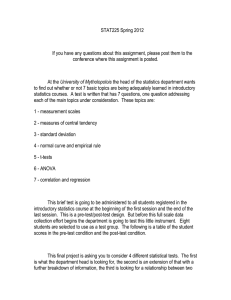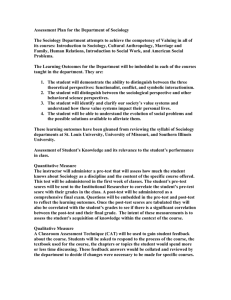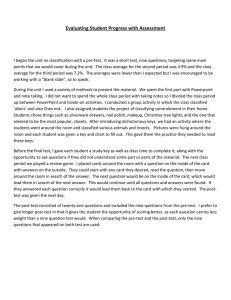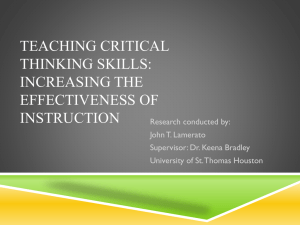Document 10465360
advertisement
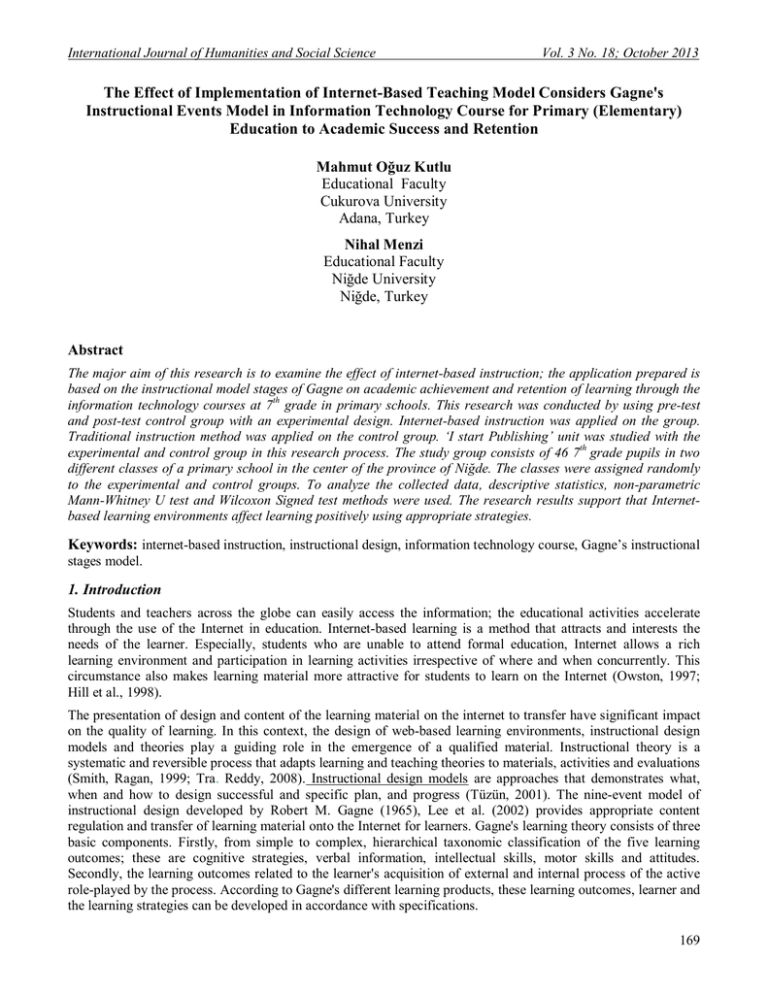
International Journal of Humanities and Social Science Vol. 3 No. 18; October 2013 The Effect of Implementation of Internet-Based Teaching Model Considers Gagne's Instructional Events Model in Information Technology Course for Primary (Elementary) Education to Academic Success and Retention Mahmut Oğuz Kutlu Educational Faculty Cukurova University Adana, Turkey Nihal Menzi Educational Faculty Niğde University Niğde, Turkey Abstract The major aim of this research is to examine the effect of internet-based instruction; the application prepared is based on the instructional model stages of Gagne on academic achievement and retention of learning through the information technology courses at 7th grade in primary schools. This research was conducted by using pre-test and post-test control group with an experimental design. Internet-based instruction was applied on the group. Traditional instruction method was applied on the control group. ‘I start Publishing’ unit was studied with the experimental and control group in this research process. The study group consists of 46 7th grade pupils in two different classes of a primary school in the center of the province of Niğde. The classes were assigned randomly to the experimental and control groups. To analyze the collected data, descriptive statistics, non-parametric Mann-Whitney U test and Wilcoxon Signed test methods were used. The research results support that Internetbased learning environments affect learning positively using appropriate strategies. Keywords: internet-based instruction, instructional design, information technology course, Gagne’s instructional stages model. 1. Introduction Students and teachers across the globe can easily access the information; the educational activities accelerate through the use of the Internet in education. Internet-based learning is a method that attracts and interests the needs of the learner. Especially, students who are unable to attend formal education, Internet allows a rich learning environment and participation in learning activities irrespective of where and when concurrently. This circumstance also makes learning material more attractive for students to learn on the Internet (Owston, 1997; Hill et al., 1998). The presentation of design and content of the learning material on the internet to transfer have significant impact on the quality of learning. In this context, the design of web-based learning environments, instructional design models and theories play a guiding role in the emergence of a qualified material. Instructional theory is a systematic and reversible process that adapts learning and teaching theories to materials, activities and evaluations (Smith, Ragan, 1999; Tra. Reddy, 2008). Instructional design models are approaches that demonstrates what, when and how to design successful and specific plan, and progress (Tüzün, 2001). The nine-event model of instructional design developed by Robert M. Gagne (1965), Lee et al. (2002) provides appropriate content regulation and transfer of learning material onto the Internet for learners. Gagne's learning theory consists of three basic components. Firstly, from simple to complex, hierarchical taxonomic classification of the five learning outcomes; these are cognitive strategies, verbal information, intellectual skills, motor skills and attitudes. Secondly, the learning outcomes related to the learner's acquisition of external and internal process of the active role-played by the process. According to Gagne's different learning products, these learning outcomes, learner and the learning strategies can be developed in accordance with specifications. 169 © Center for Promoting Ideas, USA www.ijhssnet.com Thirdly, Gagne revealed that the nine-step learning situation for appropriate learning strategies can be effective in teaching a subject or course. This is consistent with the mental process of nine-step learning situation. Learning stages ordered in accordance with the realization of the mind (which is the process of learning (Gunter et., 2006; Krullet al., 2010). Gagne stated the stages of learning, the learner and the learner's cognitive processes associated with internal process. Nine of each learner's stage of education corresponds to the stage and takes place in the minds is shown in Table 1 (Kruse, 2009). Table 1. Gagne’s Learning Stages and Mental Process Instruction Condition Attracting attention Informing the learners about the aims of the course Reminding former learnings Presentation of the stimulus material. Guiding to learner. Bringing tolight the behavior. Giving feedback. Evaluation. Providing learning retention and transition. Mental Process Situmulating receivers Forming expectation about learning. Sending the information from long term memory for short term memory. Selectivity of Perception. Coding the information to long term memory. Verifying the coding. Strengthening learning / correcting wrong learning. Remembering / forcing for recalling. Using the learning in new condition and generalization Studies in the literature examined, Gagne's instructional stages for the design of web-based learning environments shows that an appropriate theoretical framework (Gün and Sünbül, 2004; Ma, 2008; Theng and Mai, 2009; Özkök, 2010). Gagne's learning stages are the basics for the design of web pages on computer or web environment. These stages support the mental process that corresponds with mobilizing (Stemler, 1997). In this study, observable behavioral learning does not consist of only an individual's mental process, arguing the effect of cognitive and behavioral approaches to learning linked with Gagne's instructional stages model (Kane, 2006). Web-based training combines traditional classroom learning environment. Internet-based learning environment take into account the educational status of the stages of Gagne for instructional preparation of teaching 7th grade unit "I start publishing", the effect of the application for learners were investigated. In this perspective, subproblems were mentioned below. Is there statistically significant difference between the pre-test achievement scores of experimental group and the pre-test of control group? Is there statistical significant difference between the post-test achievement scores of control group and the pre-test achievement score of control group? Is there statistical significant difference between the post-test achievement scores of experimental group and the pre-test achievement score of experimental group? When pre-test achievement scores of experimental and control group have been checked, is there statistical significant difference between the post-test achievement scores of experimental group and the post-test achievement scores of control group? When post-test achievement scores of experimental and control group have been checked, is there statistically significant difference between the retention test scores of experimental group and control group? 2. Method True experimental design was used in order to reveal the method and the application impact on students' achievements in this study. Experimental researches aim to explore the cause and effect relationships. Research problem, sub-problems and hypotheses were placed; the data obtained from the sample group was introduced with guessing and assumption results (Kılıç and Cinoğlu, 2008). The sample group is believed to represent the universe. True experimental design on the control group with pre-test and post-test is the model for this study. Multiple groups are used in true experimental model and these groups are created randomly. The model includes pre-test and post-test assigned randomly and equally as experimental and control groups before and after measurement is made for both groups (Karasar, 2009). 2*2 iconic view of the research model is used in the experimental pattern as follows: 170 International Journal of Humanities and Social Science Vol. 3 No. 18; October 2013 Table 2. Pre-test Post-test Control Group Sample PRE-TEST GE GC R R O1 O2 X POSTTEST O3 O4 Internet-based information technology course is given in Table 2 on the experimental and control group as GE (GD), GC (GK). The control group presented the course in traditional teaching method in the school. The students group R was chosen randomly. O1 and O3 represent the pre-test and post-test measurements of the experimental group, Q2 and Q4 represents the pre-test and post-test measurements of the control group. X represents the independent variable; (experimental variable) applied to students in the experimental group (Büyüköztürk, 2007). Students' achievement test scores are the dependent variable and the independent variable is the teaching method applied. In order to bring about the equal dispersing of the groups before the experimental process, the experimental groups and the control group pre-test scores are based on the application of the achievement test whether or not statistically significant difference analyzed with Mann-Whitney U test and the results are presented in Table 3. Table 3. The results of U test about the achievement pre-test mean scores of the experimental and control group students. Group Experimental Control N 25 21 Mean Rank. 22.14 25.12 Mean Sum. 553.50 527.50 U 228.50 p .448 When Table 3 was analyzed between the average scores of the experimental and the control groups on the pretest, there was no significant difference according to U test results and Mann Whitney U test results as compared to the mean difference between the observed (U=228.50, P>.05). The mean rank of the students about experimental and control group were assigned randomly as B and C classes in the pre-test and there was no statistical significant difference between the mean rank of pre-test of experimental and control group. It presented that the groups were similar (Büyüköztürk, 2007, p.22). 3. Study Group Forty-six 7th grade students as B and C classes in a primary school in the center of Niğde consist of the study group randomly. B class was assigned as experimental group, C class was assigned as the control group. Before the application, there was no significant difference between the pre-test and the achievement test scores of the students in the experimental and the control group. 4. Data Collection 4. 1. Achievement Test Development The topics of the unit "I start publishing" consisting of the achievement test were used as data collection tool. Multiple-choice test was based on M.E.B (Ministry of Education) (2009) the contents of Information Technology Text book for the preparation of multiple-choice test. Table 4 shows the indicator chart about the targets based on the topics. 171 © Center for Promoting Ideas, USA www.ijhssnet.com 1.He/She makes addition appropriate for the page created on Word proccessor. 2.He/She is trying to take into account the dimensions of the storage while he/she is studying files and folders on the computer. 3.He/She discovers using a variety of writing forms and writing effects of newspaper, messages to deliver effectively . 4.He/She sets up the page settings on desktop publishing program for a particular purpose. 5.He/She makes the necessary additions on a desktop publishing program. 6.He/She formats the page appropriate for the purpose on a desktop publishing program. TOTAL TOTAL Deskktop Publishing Program (Publisher) ATTAINMENT (ACQUISITION) Digital Sizes (Ölçüler) TOPICS Word Processor Program (Word) Table 4. The indicator chart of distribution goal-topic of the unit "I start publishing" X 1 X 1 1 1 X 1 X 1 X 1 X 4 1 6 According to the distribution of test substances included on the "I start publishing" unit's topics given in Table 5. Table 5. Distribution of trial test prepared for the topics of the unit “I start publishing” ATTAINMENT/ACQUSITION 1.He/She makes addition appropriate for the page created on Word proccessor. 2. He/She is trying take into account the dimensions of the storage while he/she is studying with files and folders on the computer. 3. He/She discovers a variety of writing forms and writing effects of newspaper, messages to deliver effectively . 4.He/She sets up the page settings on desktop publishing program for a particular purpose. 5.He/She makes necessary additions on a desktop publishing program. 6.He/She formats the page appropriate for the purpose on a desktop publishing program. TOTAL ITEMS 2,4,6,7,18,19,20, 21,27,28,29,34 1,8,10,13 TOTAL 12 % 30 4 10 14,17,30,40 4 10 5,11,15,22,25,26, 33,35 12,16,23,31,37,38 3,9,24,32,36,39 8 20 6 6 15 15 40 100 Achievement test items consist of 40 questions, each half of the substances selected among those with the highest distinction applied to the ultimate test. When selecting the items in the achievement test, primarily measured behavior and the scope validity of the best item are considered. The best three items were inserted into the test (Baykul, 2000). The scope of the topic and the characteristics of the students level was taken into account for the formation of the final test consisting of 20 questions. 40 questions were prepared as an experiment. 172 International Journal of Humanities and Social Science Vol. 3 No. 18; October 2013 In accordance with the achievements in the information technology course, curriculum was prepared in accordance with item pool consisting of 40 questions as submitted based on expert opinion. The expert opinion about the questions formatted in accordance with the article pool and a 40-question multiple-choice test taken the final shape and then applied to the two primary schools consist of 216 students, one with the lowest level of success and the other with high level of success in the province of Niğde. Tavşancıl (2010, p.142) indicated trial attempts to obtain a reliable result from the number of groups; applied trial test at least five times more than the number of item in the test as stated. Trial prepared for this study owing to the formation of 40-question test could be sufficient for at least 200 students. ITEMAN validity and reliability analysis of substances result of the trial application for Windows 3.5 by an item analysis program; the results are given in Table 6. Table 6. The trial test of difficulty and distictiveness indexes Attainment Item No p rjx 1 2 4 6 7 18 19 20 21 27 28 29 34 1 8 10 13 14 17 30 40 5 11 15 22 25 26 33 35 12 16 23 31 37 38 3 9 24 32 36 39 0.80 0.59 0.50 0.75 0.25 0.46 0.25 0.50 0.79 0.45 0.77 0.77 0.72 0.78 0.87 0.63 0.88 0.41 0.73 0.81 0.75 0.59 0.19 0.41 0.60 0.66 0.69 0.70 0.63 0.44 0.38 0.79 0.23 0.61 0.80 0.86 0.94 0.50 0.65 0.55 0.60 0.54 0.30 0.43 0.18 0.30 0.36 0.33 0.41 0.11 0.35 0.34 0.39 0.37 0.20 0.47 0.34 0.54 0.55 0.27 0.41 0.39 0.06 0.56 0.35 0.41 0.50 0.48 0.32 0.49 0.38 0.51 0.37 0.47 0.40 0.48 0.23 0.61 0.51 0.56 2 3 4 5 6 173 © Center for Promoting Ideas, USA www.ijhssnet.com Analysis of the test items’ results was applied to the 216 students in Table 6. According to the results of the analysis of item difficulty and distinctive 40 questions by selecting the most suitable materials are shown in bold font in the table. The first index the selection of the materials distinctive power, and then examined the indexes of difficulty. Özçelik (2000) indicated that the difficulty of each item used in the tests for educational purpose should also be around 0.50. When selecting materials for each achievement index, the distinctive power should be preferred and those under the 0.20 should not be preferred and distinctive 0.20 (Baykul, 2000). Achievement test items for the test of 40 questions; half of each substance selected among those with the highest distinctive substances applied to the ultimate test. Achievement tests when selecting material primarily measured by the behavior of the test substance in mind, the scope and validity of each behavior post the best three items inserted into the executed test (Baykul, 2000). For this study, the scope of the topic and the student level taking into account the characteristics of forming the final test of 20 questions thought- experiment as a test of 40 questions prepared twice. "I start publishing" unit in acquisition, the total of 6 respectively 12, 4, 4, 8, 6 and written 6 sixitem result of the item analysis distinctiveness, the highest 6, 2, 2, 4, 3 items were substance. Distinctive powers of the two substances with the same distinctive power index of the item difficulty index were taken into account during selection. In addition, descriptive statistics at the trial of the test are shown in Table 7. Table 7. The descriptive statistics about the trial test of the students Trial Test N 216 Min. 0 Max. 35 X 23.23 S 6.70 α 0.85 As it can be seen in Table 7, the arithmetic average mean obtained from the students' test scores (X) is 23.23, standard deviation (SD) is 6.70 and reliability coefficient (α) is 0.85. Nunnually (1978) stated that cronbach alpha reliability coefficient value (0.70) and the above could be considered a reliable measurement tool (Eroğlu et al., 2011). Achievement test developed for this study can be said to be reliable, in addition mode value (peak value) is 25, the median (value) is 24 and the mean (arithmetic mean) value (X) 23.23, while the average difficulty of the students' trial test score was found to be 0.581. Mode (Peak) value points the biggest frequency was collected and the arithmetic mean and the median were compared for frequency distribution used for interpretation (Turgut, 1992; Eroğlu., 2011). According to this case, distribution is normal, skewed to the left, a successful distribution, and the distribution can be said successful in medium difficulty. 5. Implementation of Internet Based Course Design Information technology ministry of education for 4th and 5th step teacher's guidebook for primary education (2009) is based on the design of a web-based application used in the study. The unit "I start publishing" course content was transferred to the Internet with shape-images by using elements of interactivity and video. The steps of Gagne’s model of instructional theory were taken into account for delivery of content in the Internet environment. The student in the experimental group learned the lesson by studying on the published website. The research was carried out on both the experimental and the control group while the course was presented through the internet-based education by consulting. 6. Data Analysis Descriptive statistics, Mann Whitney U and Wilcoxon-signed test were used for data collection in analysis. Mann Whitney U test analyzes on the experimental and control group pre-test scores, test scores and retention test scores by taking the last two unrelated groups of sampling points, regardless of the number of the smallest and the highest points in the correct order were presented. The highest score, the first value given the small number of sequences were the most points by correctly, then the pre-test, post-test and retention scores depend on the experimental and the control groups as compared to the rank mean. Wilcoxon signed test sorts the experimental and control group pre-test and post-test on the different scores separately from small to large and ordinal numbers starting from 1 without attention to the mark then the + and as marked difference in the number of points collected. The differences between these two ordinal numbers are compared. Wilcoxon signed rank test was also used in the z-test statistic. The level of significance in interpreting the results of analysis "0.5" has been considered in interpreting the result of analysis. 174 International Journal of Humanities and Social Science Vol. 3 No. 18; October 2013 7. Findings 7.1. Findings on the First Sub-Problem Mean, standard deviation and N values of achievement test related to the pre-test of the experimental and control group students are given in Table 8. Table 8. The descriptive analysis statistic results of the experimental and control group students' achievement pre-test score. Group Experimental Control X N 25 21 10.56 9.71 S 2.96 3.35 Med. 10 9 Mod. 14 9 Min. 6 4 Max. 15 15 Skew. 0.071 -0.008 Kurt. -1.49 -1.06 As can be seen in Table 8, where the application of web-based courses, arithmetic mean of the experimental group X equals 10.56, while the standard deviation is S equals 2.96. In the control group, these values X equals 9.71 and Standard deviation is 3.35. In addition, each of the two groups is between -1 and +1, the skew coefficients shows a significant deviation from normal the distribution and the mode, the median, and the relationship between the arithmetic mean of the experimental group skewed to the left, the control group showed that a normal distribution can be interpreted. Forming the first sub-problem of the study of the experimental group, the control group pretest achievement score was a significant difference between pre-test scores. Kolmogorov Smirnov and Shapiro Wilk were analyzed in order to decide whether the groups with statistical method showed a normal distribution (Kalaycı, 2010). The result of pre-test was analyzed with Shapiro Wilk-W test to determine whether the results showed a normal distribution or not (Table 9). Table 9. Normality test results of the groups' total scores. Achievement Test Total Score Kolmogorov-Smirnov(a) Statistic sd P .17 46 .002* Shapiro-Wilk Statistic sd .93 46 p .006* *p<.05 According to ShapiroWilk-W test, result shows significant differences in the total test scores of the normal distribution. Therefore, the difference between the test scores of the experimental and control group with nonparametric (nonparametric) tests were examined. The number of students participating in the experiment was less than 30 in each group (Yılmaz and Yılmaz., 2005) and their total test scores, the distribution of pre-tested groups unable to meet the assumptions of parametric tests, the non-parametric Mann-Whitney U test also was applied to the test methods for independent samples t-test and for parametric test methods (Sümbüloğlu K. and V. Sümbüloglu, 2007, p.147). Depending on the pre-test mean scores of the experimental and control group, MannWhitney U test results were examined as the mean of the results given in the method section (see Table 3). 7.2. Findings on the second Sub Problem The second sub-problem of the study is the difference between the pre-test and post-test scores success of the control group analyzed with the non-parametric methods Wilcoxon signed rank test. The analyzed results are given in Table 10. Table 10. The Wilcoxon signed-test result related with the mean score of the achievement pre test and post test of the control group students. Pretest-Posttest Negative rank Pozitive rank Equal N 8 12 1 Mean Rank. 7.94 12.21 Sum Rank. 63.50 146.50 Z -1.55 p 0.121 *p<.05 As can be seen in Table 10, the pre-test of the students in the control group (X = 9.71), and the post test (X = 11.52), depending on their score and the Wilcoxon signed rank test results as compared to the mean; there was no significant difference observed (Z = -1.55, p> .05). 175 © Center for Promoting Ideas, USA www.ijhssnet.com There was no significant difference between the positive lists about positive rank of the post-test and the negative list about mean rank of pre-test. There is no difference between the mean rank and sum Z score for a level of significance viewed. 7.3. Findings on the third sub problem The third sub-problem of the study of the experimental group received pre-test and post-test analysis of the difference between the success of the Wilcoxon signed-rank test was used. The analyses of results aregiven in Table 11. Table 11. The Wilcoxon signed-test result related with the pre-test and the post-test scores of achievement test of the experimental group students. Pretest-Posttest Negative rank Pozitive rank Equal N 5 19 1 Mean Rank 10.50 13.03 Sum Rank 52.50 247.50 Z -2.80 P 0.005* *p<.05 Table 11 Wilcoxon signed-rank test was analyzed according to the results of the students in the experimental group pre-test and post-test, no statistically significant difference between the mean scores emerged. As the mean rank score on the last test of the experimental group (X= 13.03), depending on the pre-test scores as the mean rank (X = 10.50) significantly higher (Z = -2.80, p <.05). The observed difference as the sum of the different scores and the average post-test score in favor of it seems positive. These significant difference in post-test score is the average greater than the average pre-test score. 7. 4. Findings on the fourth Sub Problem Students in the experimental and control group at the end of the final test on the achievement test, mean, standard deviation, and N values are given in Table 12. Table 12. The descriptive statistics results of experimental and control groups' achievement post-test Group Experimental Control N 25 21 X 13.56 11.52 S 4.65 4.74 Med. 15 13 Mod. 18 16 Min. 4 1 Max. 20 17 Skew. -0.66 -0.83 Kurt. -0.78 -0.18 The average post-test achievement scores of the experimental group X equals 13.56 and S equals 4.65 while the standard deviation of the control group with values X equals11.52, and S equals 4.74 were presented in table 2. From the values of the other descriptive statistics, skewness coefficients of both groups is between -1 and +1, and mode, median and the arithmetic mean does not show a significant deviation from normal distribution, skewed to the left by the relationship between a successful community in which they can be distributed. Achievement test scores of the experimental and control group, controlling for pre-test and post-test achievement scores of experimental group and control group, the significance of the difference between the post-test achievement scores were analyzed by Mann-Whitney U test, results of the analysis are given in Table 13. Table 13. U test results of experimental and control groups students' achievement post test Group Experimental Control Mean Rank Sum Rank U p 20.60 515.00 190,00 0.108 26.95 566.00 *p>.05 From Table 13 examined, the experimental and the control group students on the post-test achievement scores do not show any significant difference between the means of the Mann-Whitney U test according to the results observed (U = 190.00, p> .05). 7. 5. Findings on the fifth Sub Problem The fifth sub-problem of the research was the achievement post-test mean scores of the experimental and control group, the experimental group controlled retention test while the control group controlled mean score retention test whether there is statistical significant difference between the average score of Mann-Whitney U test or not; the results were presented in Table 14. 176 N 21 25 International Journal of Humanities and Social Science Vol. 3 No. 18; October 2013 Table 14. U test mean results of experimental and control groups students' retention test Group Experimental Control N 25 21 MeanRank 19.28 28.52 MeanSum 482.00 599.00 U 157.00 P 0.019* *p<.05 From Table 14 examined, the students in the experimental and the control groups on the retention test achievement scores as compared to the mean show that there is a difference between the Mann-Whitney U Test. The total scores of the students in the experimental group as the average of the retention test, the total scores of students in the control group was significantly higher than the mean rank (U = 157.00, p <. 05). 8. Discussion As a result of the internet-based education, students in the experimental group pre-test and post-test achievement scores significantly increased when the teaching method of the control group was treated with the course of the pre-test and the post-test according to their scores, there was no significant difference in the emerged success. When the pre-test and post-test scores are successful in terms of achievement scores, it did not reveal any significant difference between the experimental and the control groups. Therefore, the web-based course has a positive effect on students' academic success. On the other hand, these effects do not demonstrate any significant difference compared with the current method of teaching.. However, the students in the control group pre-test and post-test achievement scores showed substantial gains in achievement scores significantly, the current course teaching methods processed by the effect of students' academic success is not enough to reveal. Retention test was administered two weeks after the end of the experimental procedure based on the results, the success of the students in the experimental group compared to the control group was observed. This asynchronous web-based learning environment or classroom environment, regardless of the student wants to work at their own individual environment and because of the feature (Liao and Hsieh, 2011) and the opportunity to do extra work associated with students. After controlling pre-test scores of the students in the experimental and the control group, no statistically significant difference was observed between the mean scores of the final test. Increasing the academic success with Internet-based education, with the experimental group, the control group, the success of the current teaching method showed a statistical significant increase. Internet-based text book teaching methods revealed a significant difference compared with the failure of the current teaching method, the experimental application lasts for short, students do not use internet sufficiently yet or the internet application narrowly includes a single unit interpreted. Internet-based learning environment in the literature indicated that the positive effect of students' academic achievement was found in similar studies. Wegner et al. (1999) investigated Internet-based distance education course in students' achievement and attitude towards experimental study investigated the effects of the experimental group, the internet-based instruction, the control group, the classroom environment and attitudes of the traditional teaching method, by applying the difference between the two study groups success of the test. Work as a result of the success of the students in the experimental and the control group; no significant difference was observed between the test scores. However, with the experimental group students in the class, a positive attitude towards learning environments emerged. On the other hand, Neuhauser (2010), one of the Internet-based environment teacher compared the same asynchronous teaching activities with the other face-to-face classroom environment, the impact of the two courses studied student achievement and class participation, but with no significant difference in the success of the two teaching methods emerged. Teaching activities as a result of research on the internet and face-to-face classroom environment were presented equally and concluded that learning outcomes can be achieved with both. In this study, the experimental group stages implemented by the presentation of web-based course, Gagne teaching the students in the experimental group can be said that to have a positive effect on the success of the post-test. Similar results were also observed in some studies on this issue. Theng and Mai (2009), based on the stage of Gagne's nine instructional multimediabased, student-centered and interactive learning environment and attitudes towards improving the academic achievement of the students, investigated the effect of the learning environment. 177 © Center for Promoting Ideas, USA www.ijhssnet.com Mixed method study was carried out by using the difference in students' academic achievement, achievement test (pre-test - post-test) were measured with a Likert-type questionnaire and investigated attitudes towards learning environment, students' opinions and interviews with open-ended questions. According to the results of the study, the study observed increase in the students' academic achievements and found more motivating with the multimedia-based student-centered learning environment than with the traditional classroom environment. It also supports Gagne; success in education with increase in the individual learning stages indicate the use of internetbased learning environments. Teaching teachers to reflect the views of the stages of research, teaching instruction can also be seen as a positive effect. Tanyeri (2004), based on the results of the study in the thesis; it is suitable for teachers, pedagogical Gagne's instructional stages of the building acting as a web-based teaching. Krull et al. (2010) Gagne experimental study carried out with teachers teaching teachers' stages of the course, students analyzed and investigated the impact on observing skills. According to the experimental group stages of the processes of teaching, course teachers compared to the students in the control group were observed to be dominant classes where the students learn more. Researchers, students in the course of teaching candidates observing the subsequent stages of the course serves as better to guide managing the control group; stated that candidates focused more discussing lesson. Gagne's model of instructional studies examined in the literature based on the stages of computer-based learning environments are designed to transform students in the classroom; other information indicate the performance in terms of cognitive skills (Özkök, 2010, Ma, 2008; during the day and Sünbül, 2004). The results of the study prepared on the basis of the steps listed in Gagne's instructional model for 7th grade students' academic achievement on web-based information technology course show positive effect on the sustainability of success. Various studies in the literature scanned Gagne internet-based learning environments for the design of instructional stages of the theoretical structure constitutes an appropriate supports. 9. References Baykul, Y. (2000). Eğitimde ve psikolojide ölçme: Klasik test teorisi ve uygulaması. Ankara: ÖSYM Yayınları Büyüköztürk, Ş. (2007). Deneysel desenler. Ankara: Pegema Yayıncılık. Eroğlu, M. G., & Kelecioğlu, H. (2011). Kavram haritası ve yapılandırılmış gridle elde edilen puanların geçerlik ve güvenirliklerinin incelenmesi. Hacettepe Üniversitesi Eğitim Fakültesi Dergisi. 40, 210-220. Gunter, G. A., Kenny, R. F., & Vick, E. H. (2006). A case for a formal design paradigm for serious games. The Journal of The International Digital Media and Arts Association. 3 (1), 93-105. Gündüz, Ş., & Sünbül, A.M., (2004). “İlköğretim 6. sınıf fen bilgisi dersinde, Gagne’nin öğretim etkinlikleri modeline göre hazırlanmış bilgisayar destekli öğretim uygulamasının öğrencilerin erişi düzeylerine etkisi”, IV. Eğitim Teknolojileri Sempozyumu, ss. 444-449, 24-26 Kasım 2004, Sakarya. Hill, J.R., Rezabek, L.L., & Murry, B. (1998). Web-based delivery of instruction: Prospects and challenges. American Educational Research Association, San Diego, CA. Kalaycı, Ş. (2010). SPSS uygulamalı çok değişkenli istatistik teknikleri (5. Baskı). Ankara: Asl Yayın Dağıtım. Kane, G. J. (2006). Employing cognitivist learning theories as a way to provide meaningful musical experiences within an instrumental music program. http://www.mrgregkane.net/folio/Site%20Map_files/psych_paper.pdf adresinden 10 Mart 2012 tarihinde alınmıştır. Karasar, N. (2009). Sosyal bilimlerde araştırma yöntemleri. Bursa: Uludağ Üniversitesi Basımevi. Kılıç, O., & Cinoğlu, M. (2008). Bilimsel araştırma yöntemleri. İstanbul: Lisans Yayıncılık. Krull, E., Oras, K., & Pikksaar, E. (2010). Promoting student teachers’ lesson analysis and observation skills by using Gagné’s model of an instructional unit. Journal of EducationforTeaching. 36 (2), 197–210. Kruse, K. (2009). Gagne’s nine events of instruction: An Introduction. E-Learning Guru. http://www.utsweb.net/Instructional%20Design%20Resources/GagneStyle.pdf adresinden 10 Mart 2012 tarihinde alınmıştır. Lee, W. W., Owens, D. L., & Benson, A. D. (2002). Design considerations for web based learning systems. Advances in Developing Human Resources. 4(4), 405-423. Liao, P. W., & Hsieh, J. Y. (2011). What influenced internet based learning?.Social behavior and personality. 39 (7), 887-896. 178 International Journal of Humanities and Social Science Vol. 3 No. 18; October 2013 Ma, Y. (2008). “The effects of computer animation in the design of instructional messages”, Doktora Tezi, Northern Illinois University. MEB (2009). İlköğretim 4. ve 5. basamak bilişim teknolojileri öğretmen kılavuz kitabı. Ankara: MEB Yayınları. MEB (2009). İlköğretim düşünme eğitimi 6-8. Sınıflar öğretmen kılavuz kitabı. İstanbul: MEB Yayınları. Neuhauser, C. (2010). Learning style and effectiveness of online and face-to-face instruction. The American Journal of DistanceEducation. 16(2), 99–113. Özçelik, D. A. (2000). Test hazırlama kılavuzu. Ankara: Pegem Akademi Özkök, E. (2010). “Gagne’nin öğretim modeliyle hazırlanan öğretim yazılımının ilköğretim 8. sınıf öğrencilerinin matematik dersi kareköklü sayılar konusundaki akademik başarısına ve öğrenci tutumlarına etkisi”, Yayımlanmamış Yüksek Lisans Tezi. Gazi Üniversitesi, Eğitim Bilimleri Enstitüsü, Ankara. Reddy, S. E. M. (2008). Developing implementing and evaluating computer-based instruction, Unpublished PHD. Dissertation, Indiana State University, The School of Graduate Studies, Terre Haute, Indiana. Stemler, L. K. (1997). Educational characteristics of multimedia: A literature review. Journal of Educational Multimedia and Hypermedia. 6(3/4), 339-359. Sümbüloğlu, K., & Sümbüloğlu, V. (2007). Biyoistatistik. Ankara: Hatiboğlu Basım ve Yayım. Tanyeri, T. (2004). “Fen bilgisi öğretmenlerinin web tabanlı öğretime ilişkin görüşlerinin belirlenmesi”, Yüksek Lisans Tezi. Anadolu Üniversitesi, Eğitim Bilimleri Enstitüsü, Eskişehir. Tavşancıl, E. (2010). Tutumların ölçülmesi ve SPSS ile veri analizi (Dördüncü Baskı). Ankara: Nobel Yayın Dağıtım. Theng, L. F. ve Mai, N. (2009). Effect of incorporating Gagne’s nine Instructional events in the context of multimedia-mediated student-centred learning: Study on diploma student academic performance and attitudinal feedback. Proceedings of the 2nd International Conference of Teaching and Learning (ICTL). INTI University College, Malaysia. Tüzün, H. (2001). Guidelines for converting existing courses into web-based format. Annual proceedings of selected research and development papers p resented at the national convention of the association for educational communications and technology (pp. 360-370). 13 Ocak 2013 tarihinde http://www.eric.ed.gov/ERICWebPortal/contentdelivery/servlet/ERICServlet?accno=ED470167 adresinden erişilmiştir. Wegner, S. B., Holloway, K. C., & Garton, E. M. (1999). The effects of internet-based instruction on student learning. Journal of Asynchronous Learning Networks (JALN). 3 (2), 98-106. Yılmaz, Y., & Yılmaz, Y. (2005). Parametrik olmayan testlerin pazarlama alanındaki araştırmalarda kullanımı: 1995 – 2002 Arası Yazın Taraması. Dokuz Eylül Üniversitesi Sosyal Bilimler Enstitüsü Dergisi. 7 (3), 177-199. 179
